The new normal for marketplaces in the wake of COVID-19
In the last two weeks alone global markets and consumer behavior have evolved faster than it had in the past decade. The unprecedented events we are witnessing are likely going to evolve further in the coming weeks and the results will be endured for months.
Updated on Apr 28, 2020
Almost overnight, consumer behavior has changed drastically, where a majority of offline purchases have shifted to online. According to the research firm Technomic, 52% of consumers are avoiding crowds and 32% are leaving their house less often because of coronavirus. In a market study by First Insight, 30% of respondents, all millennials, said they are now shopping online more frequently than before. According to Adobe Analytics, consumers are more likely to shop and stock for non-perishable food items and demand for these products have increased by almost 69%. All this means that most global marketplaces had to seriously alter their operations and online strategies. Surely all this increased demand brings increased revenue for marketplaces, but it is not without certain challenges..
The Impact of COVID-19 on Marketplaces
The novel Coronavirus may have turned the economy upside down for several industries, but marketplaces are seeing a surge in traffic, demand and conversions — the highest in the decade—accelerated by the shift from offline-to-offline shopping trends.
Yet this explosive growth in traffic during a sluggish economy with dull supporting infrastructure brings with it logistics and stock challenges But since this shift towards online shopping is here to stay even after the outbreak, it is worth tackling these challenges and establishing a sound business operation to prepare for the future demands.
As both buyers and sellers on marketplaces are coming to terms with the new normal, some of the top challenges they’re currently tackling are listed below. Let’s dive deep into these issues.
- Inventory shortage
- Supply chain issues
- Price gouging
Inventory Shortage
As new buying patterns emerge that drive online traffic the underlying supply chain is not sufficient to brace the increasing demand and affects the ability of sellers to restock. Buyers are also negatively impacted by the shortages in the stock chain and their needs are not being met timely.
As a result of the pandemic many marketplaces and sellers are re-evaluating their local inventory levels — with plans on having a 60-day inventory buffer to tackle possible global disruptions.
Supply Chain Issues
With the global lockdowns and international movement of goods operating at below optimal levels, marketplaces around the world are facing supply chain challenges.
Retail giant and marketplace Amazon has experienced severe strains on its supply-chain resulting in shipment delays and unavailability of non-essential products. According to Mcfadyen, last-mile delivery services such as Instacart, Shipt, Postmate, Dunzo, PeaPod and other such services are making up for the disrupted supply chain and logistics deficiency faced by retail giants.
Price Gouging
Many eCommerce sellers have engaged in price gouging and false marketing, prompting marketplaces like Amazon and eBay to remove millions of items and even suspend or ban some sellers.
In the wake of such exorbitant pricing and products with false health claims relating to COVID-19, marketplaces are feeling the heat to curb such sellers as well as remove many items being sold and restrict such sellers from the marketplace For the sellers, there is another side to the story of increased prices: the increased cost of logistics during the pandemic is reflected on the prices.
A recent article in the NYTimes, shows just how the prices for certain popular items like hand sanitizers, disinfecting wipes and N95 masks have surged in the wake of the pandemic.
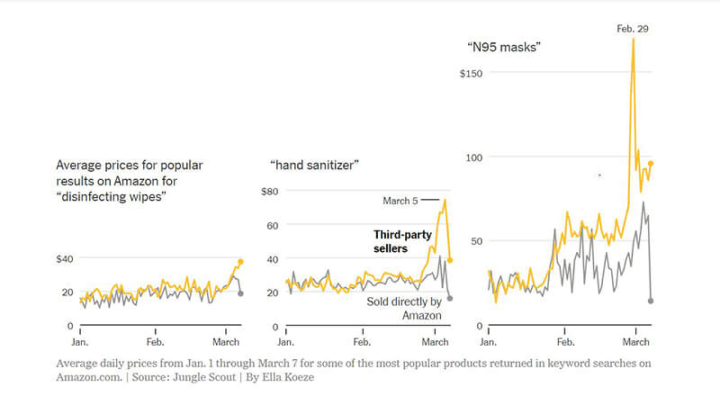
In this era of COVID-19, marketplaces have been impacted under three broad categories:
- The changing trends in consumer behavior
- The challenges in logistics and supplies
- Change in operations
The Changing Trends in Consumer Behavior
It’s apparent that consumer behavior is changing. The adoption of social distancing means that physical contact is shunned and the growth of eCommerce demand is inevitable. From bulk-buying to online shopping, people are changing what, when and how they’re buying.
According to Common Thread Collective, the three popular areas of consumer spending during this time are medical supplies, baby supplies and cleaning products.
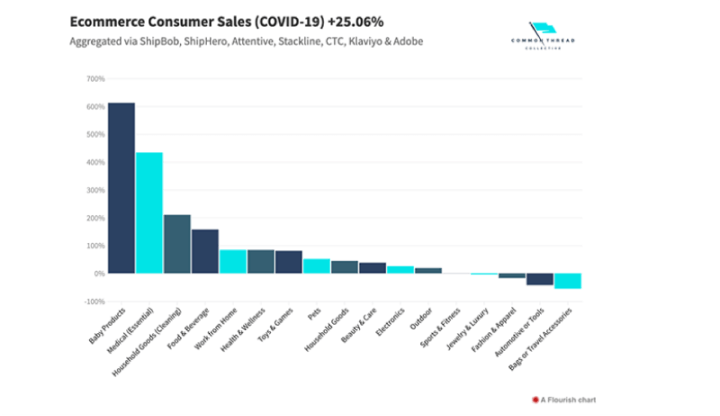
Grocery shopping soared in the first week of March after customers witnessed empty supermarket shelves—a spike of more than 150% was seen compared to 2019, according to Rakuten Intelligence.
This is perhaps a unique situation where marketplaces and eCommerce marketers do not have to actively spend on bringing traffic and visitors to their websites. The outbreak seems to have taken care of that. while the traffic may have increased, dancing to this new tune may not be as easy. That’s why we gathered some of the best strategies Marketplaces can adopt to stay ahead of the game during this new trend.
1. Let Your Customers Know You’re Involved
Everyone responds differently to a situation and during times like this pandemic, there is a lot of anxiety and miscommunication floating around. The uncertainty coupled with fear can often be devastating and lead people to make unwise decisions.
Have a dedicated section or a page on your website to help your customers understand the reality of the situation and explain what you are doing to help them during this time. It is during times of uncertainty that some of the most profound relationships are built—let your customers know that you are there for them.
Marketplaces should build transparency by publicly addressing common frustrations of customers such as delivery delays, out-of-stock products, and internal sanitation procedures. They can also take steps like providing additional training to customer service agents about handling coronavirus-related inquiries.
Walmart has a dedicated “Here For You” section that addresses a lot of relevant concerns around the COVID-19 situation and what Walmart is doing for its customers.
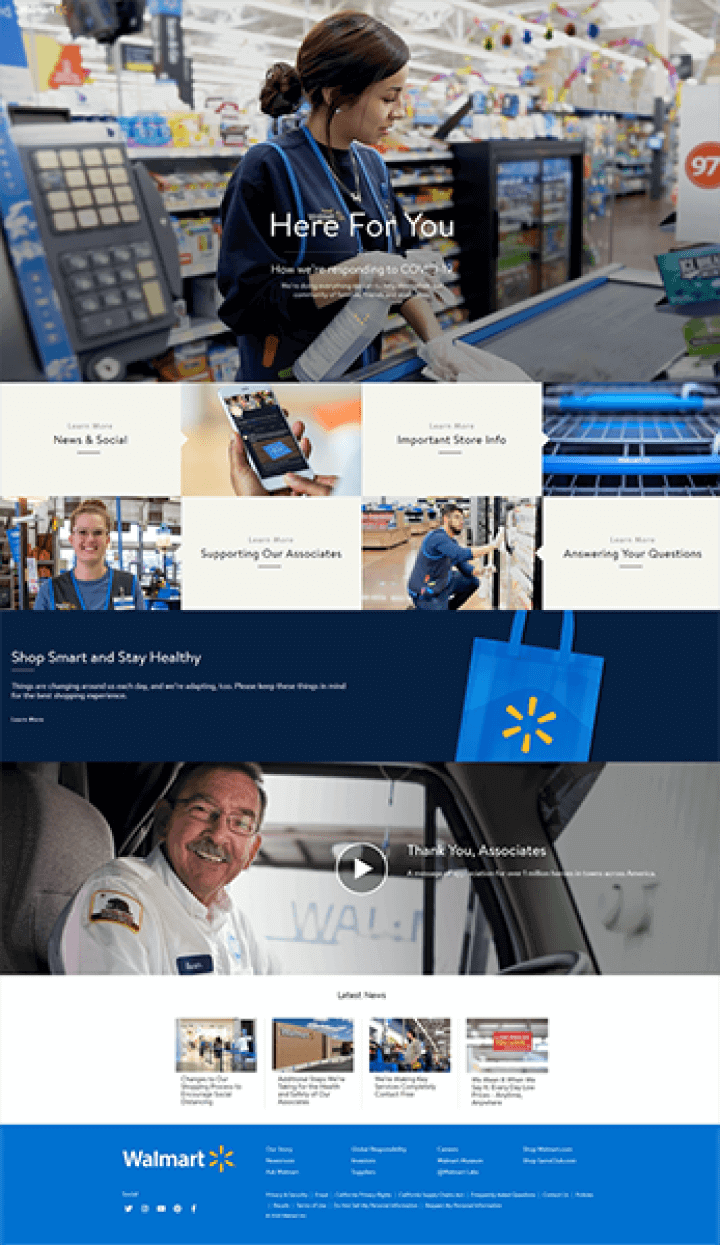
2. Prevent Panic Buying With Product Badging
Uncertain times result in unexpected behaviors and customers can often resort to panic-buying or hoarding. Marketplaces need to adopt proactive steps to discourage panic buying and encourage responsible shopping behaviors.
This ensures more than just rationing of products, and influences how customers view your brand—one that empathizes with customers through social concerns. A good way to do this is through product badging, where you limit the purchase of essential products per user.
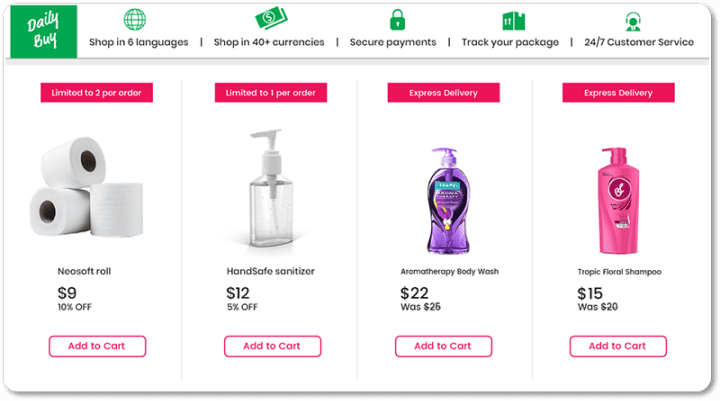
3. Encourage Planned Shopping With a Time Slot Availability Banner
The unexpected surge in traffic has presented Marketplaces with a new and unforeseen challenge—sufficiently processing the order volumes. Online Marketplaces normally have a steady order stream and their processing capacity operates with a slight buffer to cater to the seasonal surge in demand. However due to the outbreak marketplaces are witnessing an unprecedented surge in orders and need to face strain on fulfilling order processing.
You can introduce time slot availability on your website and encourage your users to plan their shopping based on slot availability. This way you can ensure smoother order processing while delivering a realistic and pleasant experience for your customers.
For sellers on marketplaces, shortages in supply and disruptions in logistics is normal during this time. While this could potentially be damaging for sales and repeat purchases, they can smoothen out the wrinkles by encouraging planned buying—introducing time-slots to better manage the supply-demand dynamics and cater to buyer expectations.
See how Walmart has tackled this problem:
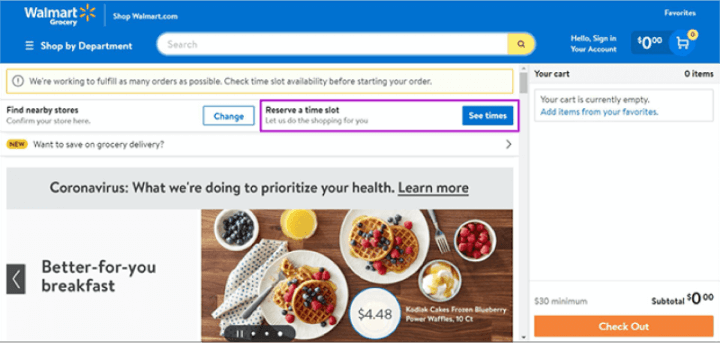
Buyers can also use this to plan their purchases this way—looking out for available time slots—to ensure a smoother and reliable order-delivery process as well as to prevent panic-buying and overstocking; which may further lead to supply shortages.
4. Promote Stay at Home Categories With Personalized Stories
Increased traffic to your website—although unexpected—presents you with the unique opportunity to improve customer experiences by promoting product categories that are most popular at a given time. Since stay at home and work from home lifestyles are presenting new and unique requirements for users, you can ascertain that most of your customers will be facing similar needs.
Tap into this insight by creating product categories designed for work from home and promote them on your website using AI-powered marketing tools like InStory. With Insider’s InStory, you can turn social distancing into an engaging online experience by powering the catchy and convenient use of social stories. You can make your trending categories take the center stage on your website or mobile app. And let your users swipe through categories with one tap.
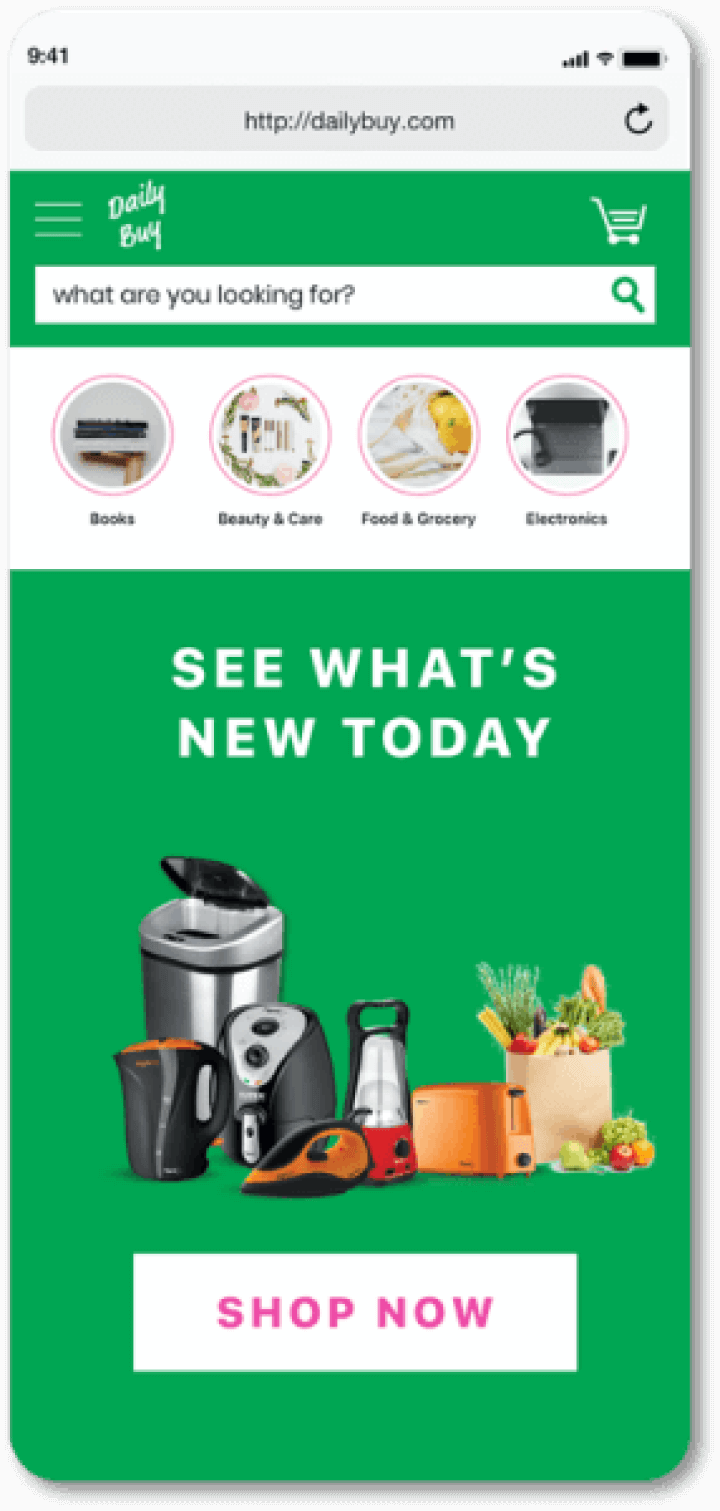

The Challenges in Logistics and Supply
Increased demand coupled with restrictions in the movement of goods, services and people have put a strain on logistics and all online brands are struggling with on-time deliveries. Delays in deliveries are expected, but it doesn’t hurt to inform your customers about this to help them plan better.
On average, across eCommerce and online retail platforms, deliveries are delayed anywhere between 7 days to 14 days. The added pressure to prioritize delivery of essentials further delays the delivery time of products that do not fall under the ‘essentials’ category,but for your customers, these goods may still be important.
5. Delays in Shipments Are Real—Let Your Customers Know
All you need is a simple hello bar or a website banner to update your customers on your delivery situation and give them a heads-up on potential delays in shipment.
Let your customers know that you are doing everything possible to stay on track and serve them as quickly as possible. For more information, redirect them to a detailed landing page where you explain the situation and the measures you have adopted in detail. See how popular marketplace Amazon addresses this challenge:
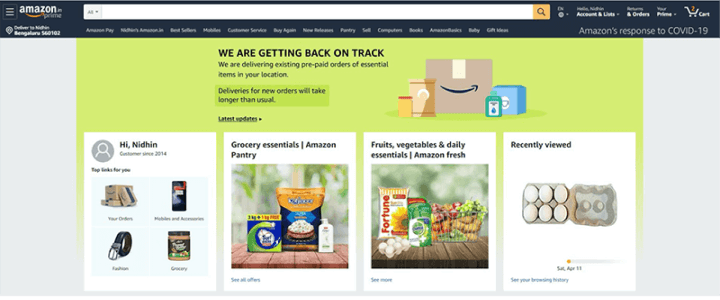
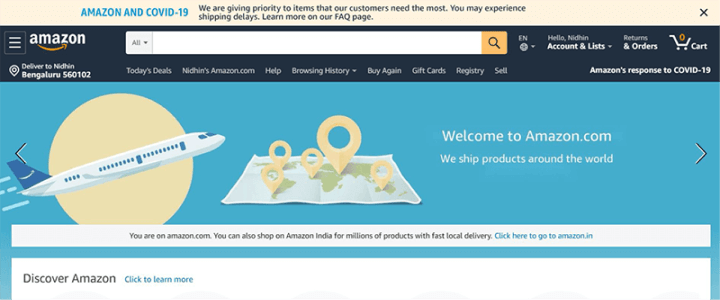
6. Out of Stock Doesn’t Mean out of Reach
Marketplaces will have to deal with greater “out of stock” situations than before. While this can be a frustrating experience for your customers, it doesn’t have to be the end of their stay on your website. Here are a few things you can do to tackle the situation.
- Implement a Zero Search Landing Page / Out of Stock Recommendations
Having a zero search (product not available) landing page with relevant recommendations for similar products that other users have purchased can serve as a great way to improve customer experience on your website. Remember, product unavailability is on the rise but you don’t have to let your users go back empty-handed.
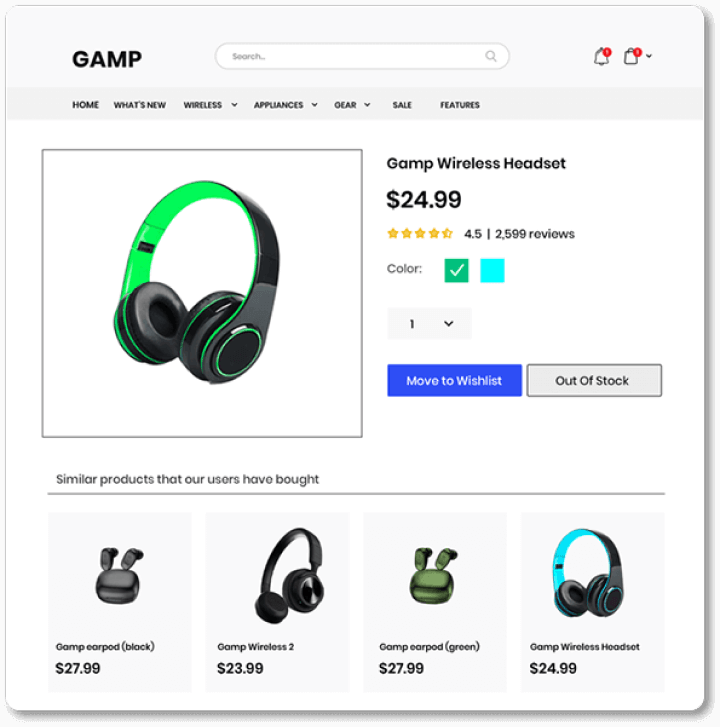
- Back in Stock Notifications
You may not be able to show related products for every out-of-stock product. But when you have an item back in stock, you would want your customer to know about it. Back-in-Stock notifications serve as a great re-engagement strategy to bring back customers and keep them updated about a product that they showed an interest in. It is an indispensable tool to have, especially at this time where you establish relationships with new customers who may be just onboarding with online shopping trends.
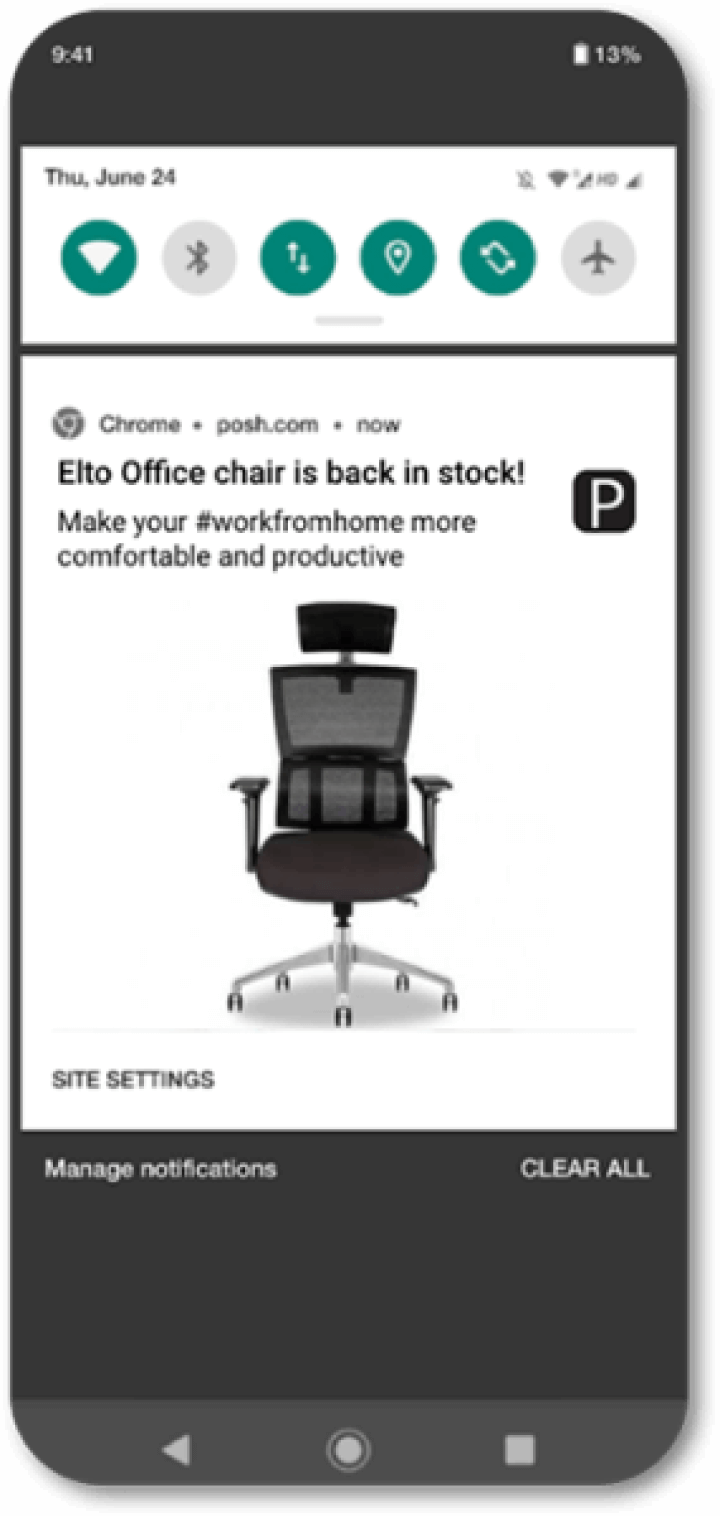
Change in Operations
The global implications of this pandemic also mean that eCommerce and Marketplace have had to make changes in their operations, from processing orders to adapting warehouse functions, employee well-being, and securing order deliveries. It’s not easy—but it has to be done.
While your customers are concerned about being able to purchase form your website and receiving their orders, albeit delayed, they are equally concerned about the safety and hygiene levels of these deliveries. Many recent findings show that the virus can live on surfaces from three hours to up to three days, depending on the material. Your customers want to know that you are following all the best practices to ensure the safety of your employees as well as safe and reliable deliveries. There are a few things you can do to ease the concerns of your customers:
7. COVID-19 Response Page | Safety First
Create a COVID-19 response page that reassures your customers about the steps you have in place to deal with the outbreak. While this might sound redundant and obvious, do not underestimate the power of a social message during this time.
It’s not only about your customers, you also need to let them know that your employees are also taken care of. It is not only about meeting orders and catering to the increased traffic during this time, but this is where you need to display your brand’s human side. One that showcases care, and empathy apart from great products. One can always draw inspiration from Amazon. On their safety section, they clearly list all the steps they are taking to address the anticipated concerns of their customers.

8. Reassure Your Customers of Fair Pricing
In the wake of the pandemic, many sellers across marketplaces have been resorting to inflated and exorbitant pricing. As a marketplace, you have a moral obligation to control the prices of products being sold on your website.
Like Amazon, you can also respond to price gouging with a fair pricing policy ensuring your buyers of fair prices and warning sellers who try to take advantage of the situation.
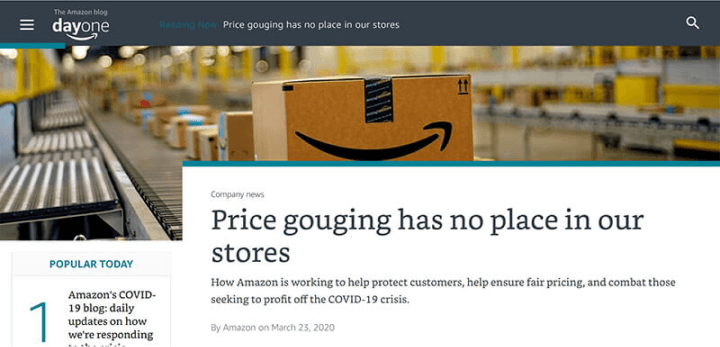
What Does The Future Look Like?
COVID-19 has impacted the global economy and the impacts are both micro and macro. While the long-term ramifications of this are yet to be ascertained, what is clear is that many aspects of customer behavior and how they interact with brands will forever be changed.
This immediate shift from offline to online and the reliance on eCommerce channels for purchasing vital supplies indicate the scope for long term habits that will remain ingrained as the pandemic-related measures stay in place and the slow march towards a global recovery takes place.
Let’s not forget that digital transformation and scaling digital infrastructure has been the focus of marketplaces for many years now — but it is only in the light of this pandemic that adoption and scale-up have seen a push — the COVID-19 may be the single most effective catalyst.
This leaves marketplaces with certain key-focus areas to build-on and improve, to prepare for the post-coronavirus world.
Retaining New Customers
The pandemic has certainly brought a whole new section of the population online—even those who preferred offline stores to online purchases are now shopping online and trends predict these users will continue to do so even after this blows over.
Marketplaces, therefore, need to focus on the customer experiences that they are able to deliver to their users during the time of this crisis, as that will dictate how users view your brand when things go back to normal.
Diversifying Your Supply Chain
If there’s one thing we’ve learnt from this pandemic, it’s how frail the supply chain can be, especially during crisis times. So it’s essential to take necessary steps to ensure long term sustainability.
Diversifying both manufacturing and fulfillment locations when and where possible is a good strategy and it’s best to get started right now. While diversifying the manufacturing side can take longer, the fulfillment side can be achieved much quicker.
In recent years a lot of U.S retailers have moved their production to China—a classic case of all eggs in one basket—and now paying a heavy price as a result of this pandemic. Many companies have now reallocated sourcing to other countries like Vietnam or re-shored a portion of their manufacturing. while others set up multiple facilities in different countries to mitigate any potential future risk. But with the global economy being affected, nothing is fool-proof at the moment.
For the buyers, this could mean potentially higher prices. Companies have diminished negotiation power when production is diversified across geographies. Leaving them to transfer the additional costs for shipping from multiple facilities onto the products. It might be tough on consumers but a boon for sellers and supply chain businesses. While an expensive alternative, it does prove helpful during unexpected disruptions such as this pandemic.
The good news is that the supply-chain is flexible and resilient.his adaptability means that it can become even stronger. China’s role as a unique production and supply-chain hub took a hit when the pandemic emerged and showed the world the absolute need to diversify existing supply-chains with more distributed and coordinated strategies across geographies.
Connect With Customers on Social Channels
Right now, nobody wants to be sold to—your customers are looking for connections—and this is the perfect time to build those connections.
Did you know that 90 percent of Instagram users follow a brand or brands on Instagram? Build up your social media strategies and engage with your users, inviting them to become a part of your brand, share stories, experiences and much more. As the stay-at-home social structure continues to be extended, people are always looking for new ways to interact, make sure you get on board.
According to Nielsen’s survey, 84% of people reported as trusting a social media recommendation for their future purchases. How you engage with your customers today will play a huge role in how they perceive your brand after this crisis.
Key Takeaways
This is certainly a precarious situation for markets, businesses and people. Since there is no foreseeable timeline for an end to this pandemic, there is general confusion and concern in the air. But overall, brands in the market segment are witnessing an increased demand—and this is your chance to stand out by being the thought leaders in your industry, delivering convenience and expressing care in your engagement with customers.
There are obvious and not so obvious restrictions that place you at a disadvantage and therefore it is imperative that you follow a transparent communication process with your customers. And remember, great relationships and experiences are forged in the heart of turbulent times.
We’ll get through this pandemic together and, as a united front, we’ll continue to work towards the betterment of our digital customer experiences.



















